🐳 Irrigation Methods
Learn about various methods of irrigation.
Types of Irrigation
- Surface Methods
- Sub-Surface Methods
- Micro Methods
Surface Irrigation Methods
Flood Irrigation

- Used for
lowland riceand other crops. - Water is allowed from the channel into the field without much control on either side of the flow.
- It covers the entire field and move almost unguided.
- The height of bunds around the field should be 15 cm for effective use of rainfall.
- It is a minimum labour-intensive method.
- Useful in uniform surface soils with good water holding capacity.
✅ Advantage
- Less labour required
- No extra care
- Large stream can be easily managed
❌ Disadvantage
- Uneven distribution of water
- Low water application efficiency
Basin Irrigation
- Basins are flat areas of land surrounded by low bunds.
- The bunds prevent the water from flooding to the adjacent fields.
- The basins are filled to desired depth and the water is retained until it infiltrates into the soil
- Water may be maintained for considerable periods of time.
- Basin method may be divided into two types: Check Basin method and Ring Basin method.
Check Basin Method


- The check basin method is the most common method of irrigation used in India. In this method, the land to be irrigated is divided into small plots or basins surrounded by checks, levees (low bunds).
- Each plot or basin has a nearly level surface. The irrigation water is applied by filling the plots with water up to the desired depth without overtopping the levees and the water retained there is allowed to infiltrate into the soil. The levees may be constructed for temporary use or may be semi-permanent for repeated use as for paddy cultivation. The size of the levees depends on the depths of water to be impounded as on the stability of the soil when wet.
- Irrigation efficiency of check basin is
30-40%. UPPSC 2021 - Water is conveyed to the cluster of check basins by a system of supply channels and lateral field channels or ditches. The supply channel is aligned on the upper side (at a higher elevation) of the field for every two rows of plot.
- Basin irrigation is suitable for many field crops. Paddy grows best when its roots are submerged in water and so basin irrigation is the best method for use with the crop. Also, it is suitable for closely spaced crops like maize, pearl millet, groundnut etc.
- Check basins are useful when leaching is required to remove salts from the soil profile.
- Not suitable for crops which are sensitive to wet soil conditions around the stem.
Ring Basin method
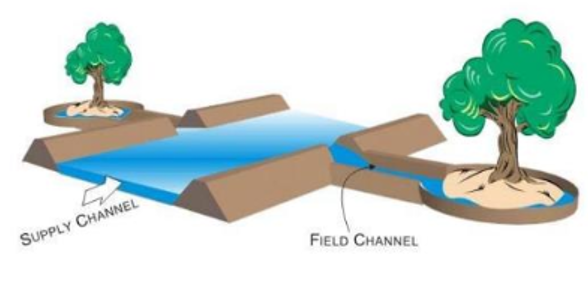
- The other form of basin irrigation is the ring basin method which is used for growing trees in orchards.
- In this method, generally for each tree, a separate basin is made which is usually circular in shape.
- Sometimes, basin sizes are made larger to include two or more trees in one basin.
- Water to the basins is supplied from a supply channel through small field channels.
✅ Advantages
- Uniformly water application.
- Suitable for those field which are quite large and not easy to level the entire field.
❌ Disadvantages
- More labour required for field layout and irrigation.
- Wastage of field/ land is more under irrigations and bunds. Mostly 5 percent of land is waste for bunding.
Border Strip Irrigation
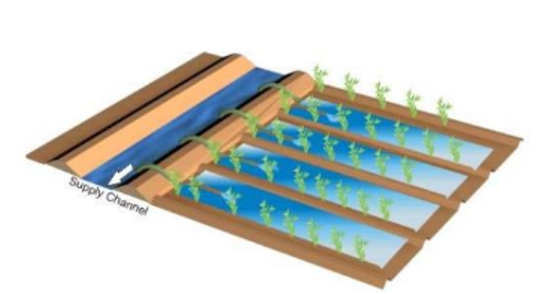
- The land is divided into number of
long parallel stripscalled borders. - These borders are separated by low ridges.
- The border strip has a uniform gentle slope in the direction of irrigation.
👉🏻 Suitability
- To soils having moderately low to moderately high infiltration rates. It is not used in coarse sandy soils that have very high infiltration rates and also in heavy soils having very low infiltration rate.
- Suitable to irrigate all close growing crops like wheat, barley, fodder crops and legumes and not suitable for rice.
- Width of border strip: It varies from 3-15 m.
- Border length varies according to topography i.e. Slope.
✅ Advantages
- Large irrigation streams can be efficiently used.
- This method gives highest water use efficiency than other surface irrigation methods.
❌ Disadvantages
- No uniform distribution of water.
- This method cannot be applied for sandy soils.
Furrow Irrigation

- Furrows are small channels, which carry water down the land slope between the crop rows.
- Water infiltrates into the soil as it moves along the slope.
- The crop is usually grown on ridges between the furrows.
- This method is suitable for all row crops and for crops that cannot stand water for long periods, like 12 to 24 hours, as is generally encountered in the border or basin methods of irrigation.
👉🏻 Mechanism of Water Supply
- Water is applied to the furrows by letting in water from the supply channel, either by pipe siphons or by making temporary breaches in the supply channel embankment.
- The length of time the water is to flow in the furrows depends on the amount of water required to replenish the root zone and the infiltration rate of the soil and the rate of lateral spread of water in the soil.
- Furrow irrigation is suitable to most soils except sandy soils that have very high infiltration water and provide poor lateral distribution water between furrows.
✅ Advantage
- Water in the furrows contacts only one half to one-fifth of the land surface, thus reducing puddling and clustering of soils and excessive evaporation of water.
Types of furrow irrigation
👉🏻 Based in alignment of furrows
- Straight furrows
- Contour furrows
👉🏻 Based on size and spacing
- Deep furrows
Corrugations: Small and shallow furrow are known as corrugation, suitable for close growing crops like wheat, ground nut etc.
Surge Irrigation

Intermittent application of water to the field surface under gravity flow which results in a series of ON and OFF modes of constant or variable time spans.
✅ Advantage
- Infiltration uniformity is increased.
- Deep percolation is reduced compared to continuous water application due to intermittent wetting and drying process.
Sub-Surface Irrigation
- The application of water to fields in this type of irrigation system is below the ground surface so that it is supplied directly to the root zone of the plants.
- In sub-surface or sub-irrigation water is applied beneath the ground by creating and maintaining an artificial water table at some depth, usually 30 to 75 cm, below the ground surface.
- Moisture moves upwards towards the land surface through capillary action to meet requirements of the crops in plant roots.
- Water is applied through underground distribution system consisting of a properly designed main field ditches, laterals, laid 15 to 30 m apart.
- Water may be obtained from wells, streams, lakes etc.
👉🏻 There may be two ways by which irrigation water may be applied below ground and these are termed as:
- Natural sub-surface irrigation method
- Artificial sub-surface irrigation method
Natural Sub-Surface Irrigation Method
- Under favorable conditions of topography and soil conditions, the water table may be close enough to the root zone of the field of crops which gets its moisture due to the upward capillary movement of water from the water table.
- This method is favorable when the following conditions exist:
- The soil in the root zone should be quite permeable
- There should be an impermeable substratum below the water table to prevent deep percolation of water
- There must be abundant supply of quality water that is one which is salt free, otherwise there are chances of upward movement of these salts along with the moisture likely to lead the conditions of salt incrustation on the surface.
Artificial sub-surface irrigation method

- The concept of maintaining a suitable water table just below the root zone is obtained by providing perforated pipes laid in a network pattern below the soil surface at a desired depth.
- This method of irrigation will function only if the soil in the root zone has high horizontal permeability to permit free lateral movement of water and low vertical permeability to prevent deep percolation of water.
- This method of irrigation is not very popular because of the high expenses involved, unsuitable distribution of subsurface moisture in many cases, and possibility of clogging of the perforation of the pipes.
Micro-Irrigation Methods
- Also known as
Pressurized Irrigation System. - Under PMKSY-PDMC during 2018-19, an area of 7.87 lakh ha has been brought under Micro Irrigation (MI).
- Total area under micro irrigation in India:
11.58 lakh ha(2018-19) under PMKSY-PDMC. Out of which 5.83 lakh ha is under sprinkler irrigation and rest 5.75 lakh ha is under drip irrigation.
👉🏻 State wise area covered under Micro Irrigation (2018)

Sprinkler Irrigation
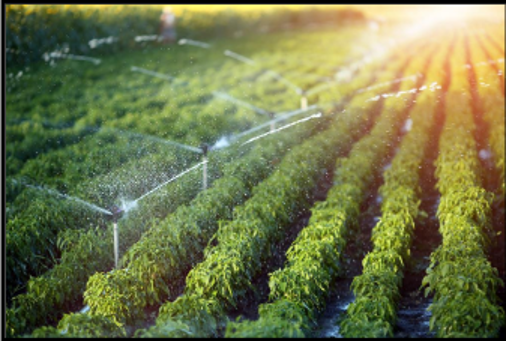
- Water is applied with pressure to the surface of any crop or soil in the form of a thin spray, somewhat
resembling rainfall. - This system consists of sprinkler heads or nozzles, which are mounted on risers in lateral lines taken from main line, which is further connected to a pumping unit.
- The rate of spray of water can be regulated and natural rainfall can be simulated.
- Sprinkler irrigation can be used for all crops, (
except rice and jute) and on most soils (except heavy clay soils). - It is especially suited for field with
steep slopes or irregular topography. - If soil erosion is a hazard, it can be used in conjunction with contour bunding, terracing, mulching and strip cropping.

✅ Advantage
- Suitable for undulating topography and sandy soils. It can be used in hilly areas.
Savingof water from25-50%for different crops.- Saving of land 10-20 per cent.
- Discharge rate is more than
1000 lit/hr. - Sprinkler pressure
2.5-4.5 kg/cm2 Water use efficiencycan be as high as60%much higher to surface method of irrigation.- Increase 40% in irrigated area with same amount of water as compared with surface method of irrigation.
- About 40-60% saving in labour compared with surface.
- It can be used to protect crops against
frost and hightemperatures.
❌ Disadvantages
- Not followed under high wind velocity (>12 km/hour).
- High initial costs.
- High energy is required (0.50 to >10 kg/cm2).
- More spreading of diseases.
- Cannot be used for rice and jute crops. (Not suitable for heavy soil)
Drip Irrigation
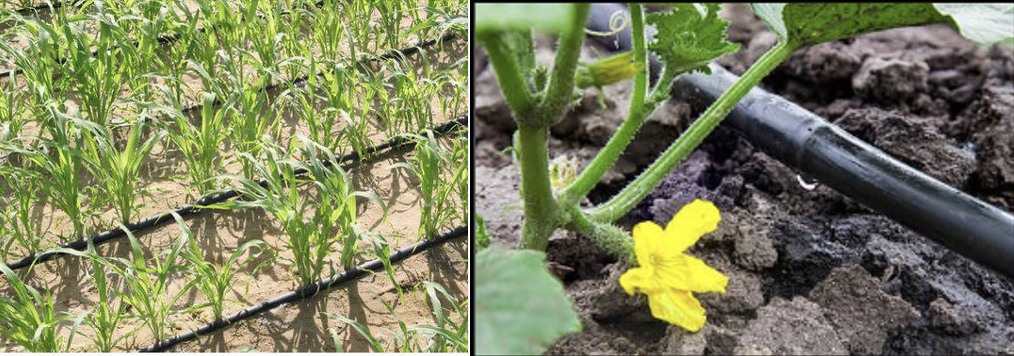
- Also known as
Trickle Irrigation. - Introduced from
Israel. Usage of a plastic emitter in drip irrigation was developed in Israel by Simcha Blass and his son Yeshayahu. RRB-SO-19 - Water is delivered at or near the root zone of plants, drop by drop.
- Drip or trickle irrigation is one of the latest methods of irrigation which is becoming increasingly popular in areas with water scarcity and salt problems.
- It provides water in root zone and prevent water losses. NABARD 2019
- Discharge rate of water per dripper is generally
1-4 lit/hr. at1.5-2.5 kg/cm2 pressure. - It consists of main line, sub pipeline, laterals and emitters.
- The discharge is from emitters.
- It saves
60-70 per centwater. - Water use efficiency is
95 %. IBPS 2018 - In modern agriculture, drip irrigation is often combined with plastic mulch, further reducing evaporation, and is also a means of delivery of fertilizer. It is also known as fertigation.
✅ Advantages
- Well suited for areas of acute water shortage.
- Minimization of soil erosion and deep percolation and runoff losses.
- Water is maintained at field capacity.
- Salt concentration is less.
- No land leveling is necessary.
- Herbigation and Fertigation can also be applied.
- Less disease and weed infestation.
❌ Disadvantages
- Clogging of emitter.
- Damage to lateral systems due to rodents and other animals.
- Salt accumulation near plants due to lack of sufficient moisture for leaching.
- High initial cost.
- Most suitable for wider spaced orchard crops and sugarcane.
- Inadequate root development.
Comparative study between sprinkler and drip irrigation

Typhoon System
- It is a type of
Drip Irrigation. - Typhoon system of irrigation is used in flat terrain and row crops. It is thin wall dripper line with very low flow rate.
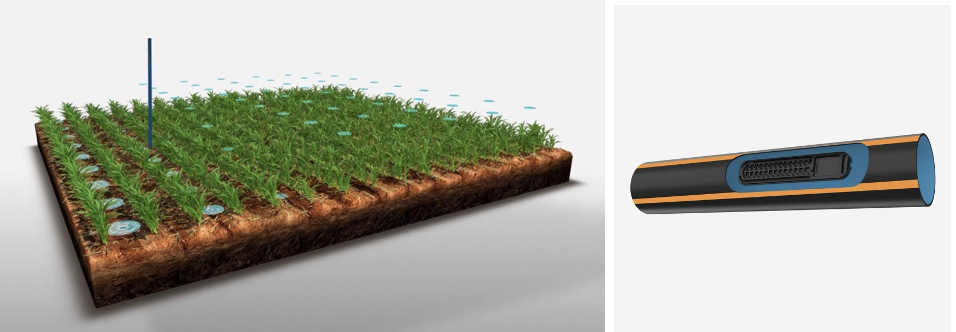
Irrigation Methods Suitable for Different Crops

👉🏻 Crop with highest irrigated area
Wheat- Rice (50 % of total area)
👉🏻 Irrigated area to net sown area
Sugarcane(93%)- Wheat (85%)
PMKSY
- Pradhan Mantri Krishi Sinchayee Yojana (PMKSY)
- According to State of Indian Agriculture 2015-16, India has a net sown area of around 140.13 million hectares of which around
68.38 million hectare(around 47%) is under irrigation. - While
71.74 million hectaresarea un-irrigated. To bridge this gap, the government launched the PMKSY in2015-16by combining ongoing schemes. - Under PDMC, Financial Assistance is available up to 55% for Small & Marginal Farmers and 45% for other farmers for adoption of Micro Irrigation system.
- The funding pattern between Central Govt. share and State Govt. share since November 2015 has been
60 : 40for all states except North Eastern & Himalayan States. For North Eastern & Himalayan States the funding pattern is90 : 10.
Types of Irrigation
- Surface Methods
- Sub-Surface Methods
- Micro Methods
Surface Irrigation Methods
Flood Irrigation

- Used for
lowland riceand other crops. - Water is allowed from the channel into the field without much control on either side of the flow.
- It covers the entire field and move almost unguided.
- The height of bunds around the field should be 15 cm for effective use of rainfall.
- It is a minimum labour-intensive method.
- Useful in uniform surface soils with good water holding capacity.
✅ Advantage
- Less labour required
- No extra care
- Large stream can be easily managed
❌ Disadvantage
- Uneven distribution of water
- Low water application efficiency
Basin Irrigation
- Basins are flat areas of land surrounded by low bunds.
- The bunds prevent the water from flooding to the adjacent …
Become Successful With AgriDots
Learn the essential skills for getting a seat in the Exam with
🦄 You are a pro member!
Only use this page if purchasing a gift or enterprise account
Plan
- Unlimited access to PRO courses
- Quizzes with hand-picked meme prizes
- Invite to private Discord chat
- Free Sticker emailed
Lifetime
- All PRO-tier benefits
- Single payment, lifetime access
- 4,200 bonus xp points
- Next Level
T-shirt shipped worldwide

Yo! You just found a 20% discount using 👉 EASTEREGG

High-quality fitted cotton shirt produced by Next Level Apparel